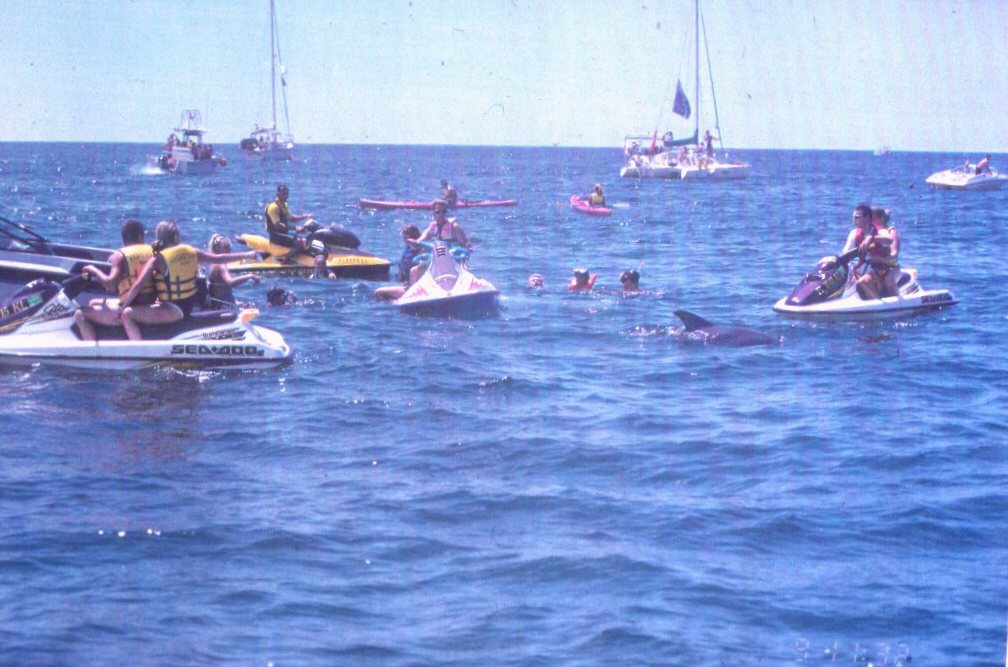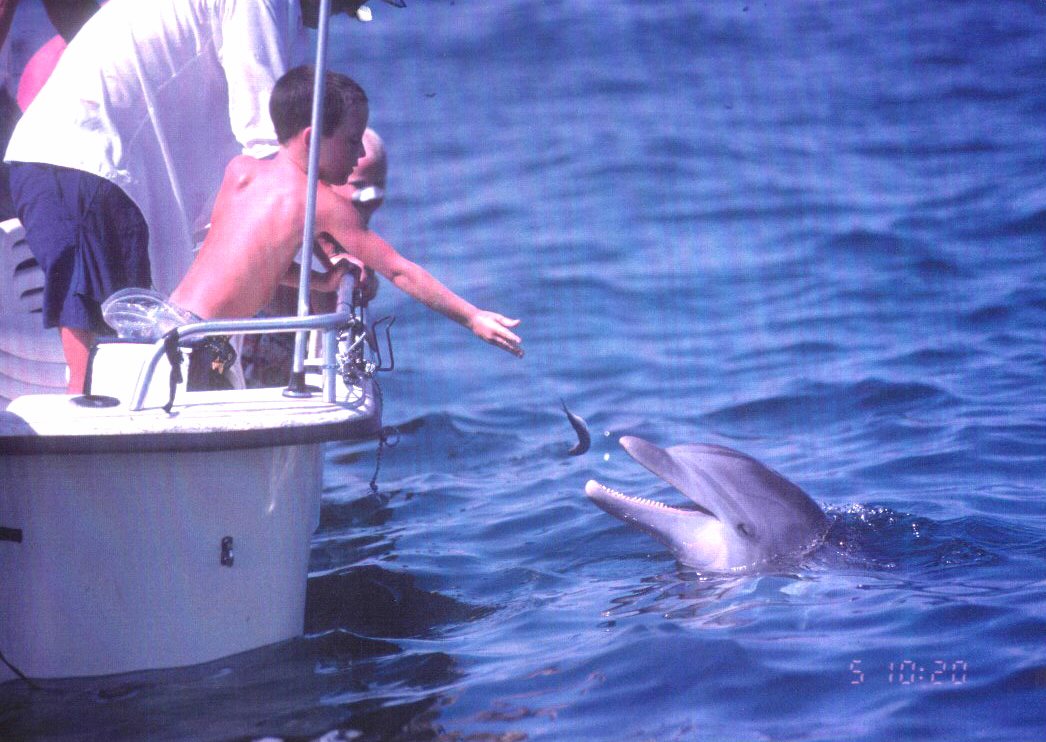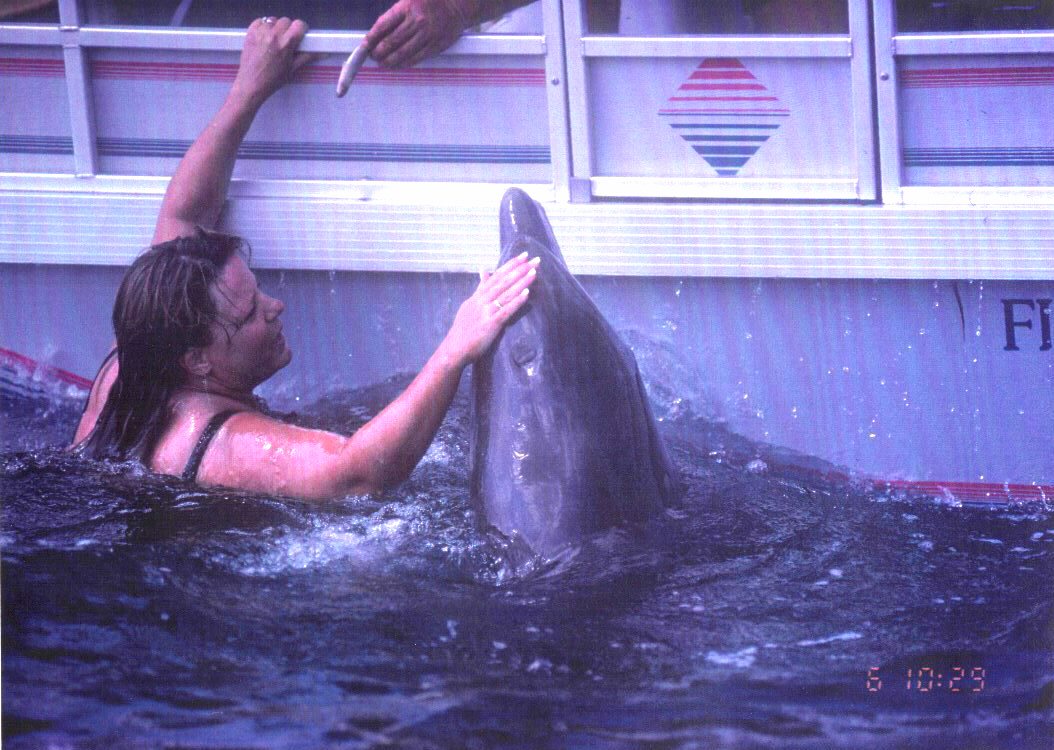
Abstract
We conducted a pilot study to evaluate the effects of habitual interaction with humans on the behavior of wild bottlenose dolphins near Panama City Beach, FL. We observed a minimum of 89 dolphins near Panama City Beach during 5 days in August 1998. We classified dolphins as “habituated” or “unhabituated” to human interaction on the basis of the presence or absence of certain behaviors, including: remain within touching distance of a human in the water or in a vessel; close approach with head up with or without open mouth; vertical lunge at vessel with or without open mouth; rapid travel (not bow-riding) to keep up with a vessel moving at speed; and accepting food handouts. These behaviors were displayed frequently by habituated dolphins, but were never exhibited by unhabituated dolphins. Using photo-identification techniques, we identified at least seven dolphins that had habitual interactions with humans near Shell Island.

Focal follows of selected dolphins showed striking differences in the lives of habituated and unhabituated dolphins. Habituated dolphins spent 77% of observation time engaged in interactions with humans, and remained at the location that we called “Interaction Beach” in the marine sanctuary. Unhabituated dolphins were observed at the same location, but never had interactions with humans and ranged widely throughout the area.
We focused on one juvenile dolphin “HiMidLo” who had habitual interactions with humans. We selected “HiMidLo” for intensive study because this juvenile was ever-present near “Interaction Beach”, and we were concerned about the effects of habitual interaction on an immature dolphin. Observations of other habituated dolphins indicated that the behavioral profile of “HiMidLo” may be typical of habituated dolphins in Panama City Beach waters.
We encountered “HiMidLo” in the vicinity of “Interaction Beach” on 4
of 5 field days, including in early morning before tour boats arrived.
In 3 focal follows (5 hrs 53 min), “HiMidLo” spent 74% of the time interacting
with humans, and was within 10 m of human swimmers for 60% of the time.
“HiMidLo” was observed to forage naturally only once, and to socialize
with other dolphins only twice. Interactions with humans put “HiMidLo”
at risk approximately once every 12 min, including being fed by humans
once every 39-59 min. 
Risky encounters for the dolphin included those in which a human and
dolphin had physical contact; humans offered food or objects to the dolphin;
humans behaved in ways that were potentially injurious or caused the dolphin
to behave submissively; the dolphin closely approached a moving propeller,
fishing gear in the water, or a vessel moving at speed; or the dolphin
was surrounded by 10 or more vessels within 10 m. In addition, humans in
the water with “HiMidLo” were at risk of injury once per 35 min. Risky
interactions for humans included making physical contact with the dolphin;
abrupt movements by the dolphin in close proximity to a swimmer; a swimmer’s
face within touching distance of the dolphin’s face; or a swimmer simultaneously
feeding and petting a dolphin.
Our observations suggest that human interaction is likely to be detrimental
to wild dolphins in Panama City waters. We observed numerous encounters
with humans that put “HiMidLo” at risk of injury, illness, or death. As
a juvenile, “HiMidLo” may be in additional danger if food provisioning
and human interaction have replaced learning the hunting and social skills
necessary for survival as a wild dolphin.
 We observed
a high rate of food provisioning of dolphins at “Interaction Beach”. Thus,
it seems likely that virtually all interactions between dolphins and humans
in this region are based on food provisioning. The effects of food provisioning
on behavior are so pervasive that it would be difficult to tease apart
which effects on dolphin behavior are due to in-water interactions with
humans and which are due to food provisioning.
We observed
a high rate of food provisioning of dolphins at “Interaction Beach”. Thus,
it seems likely that virtually all interactions between dolphins and humans
in this region are based on food provisioning. The effects of food provisioning
on behavior are so pervasive that it would be difficult to tease apart
which effects on dolphin behavior are due to in-water interactions with
humans and which are due to food provisioning.